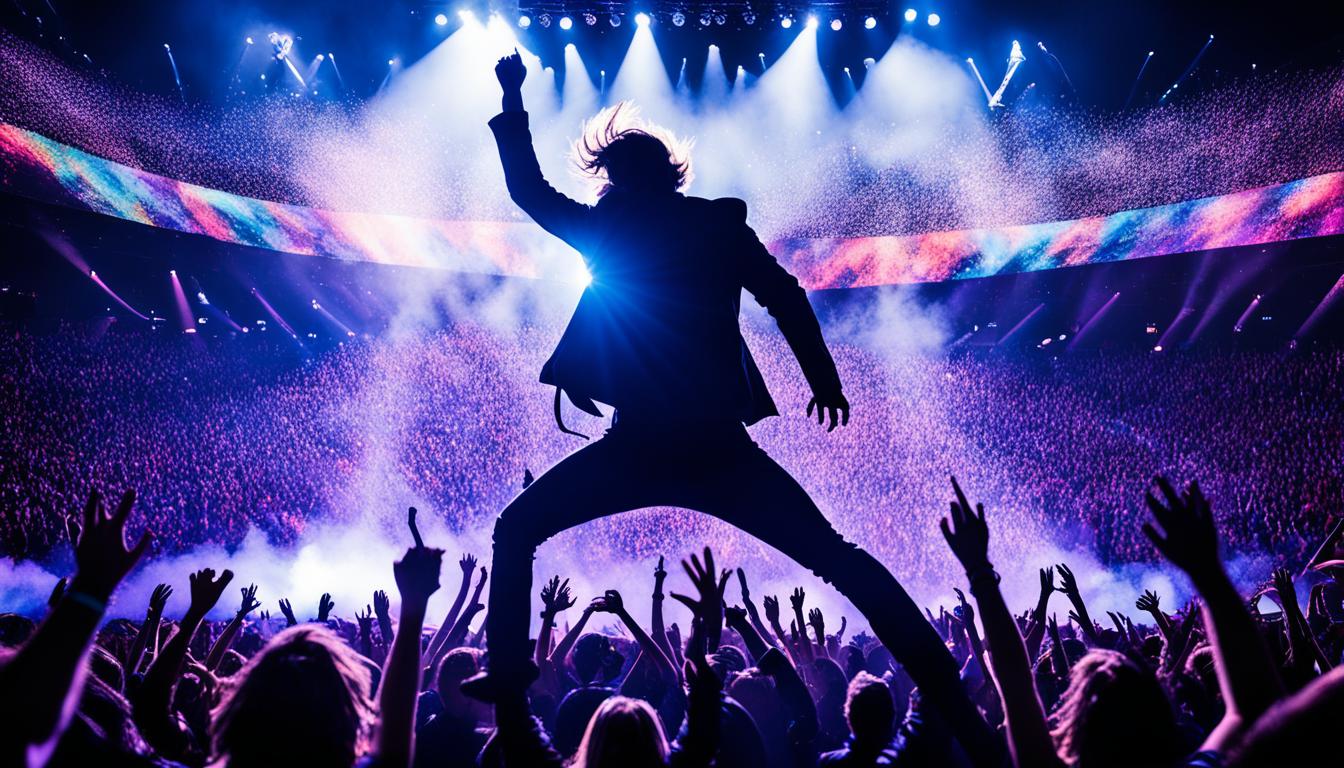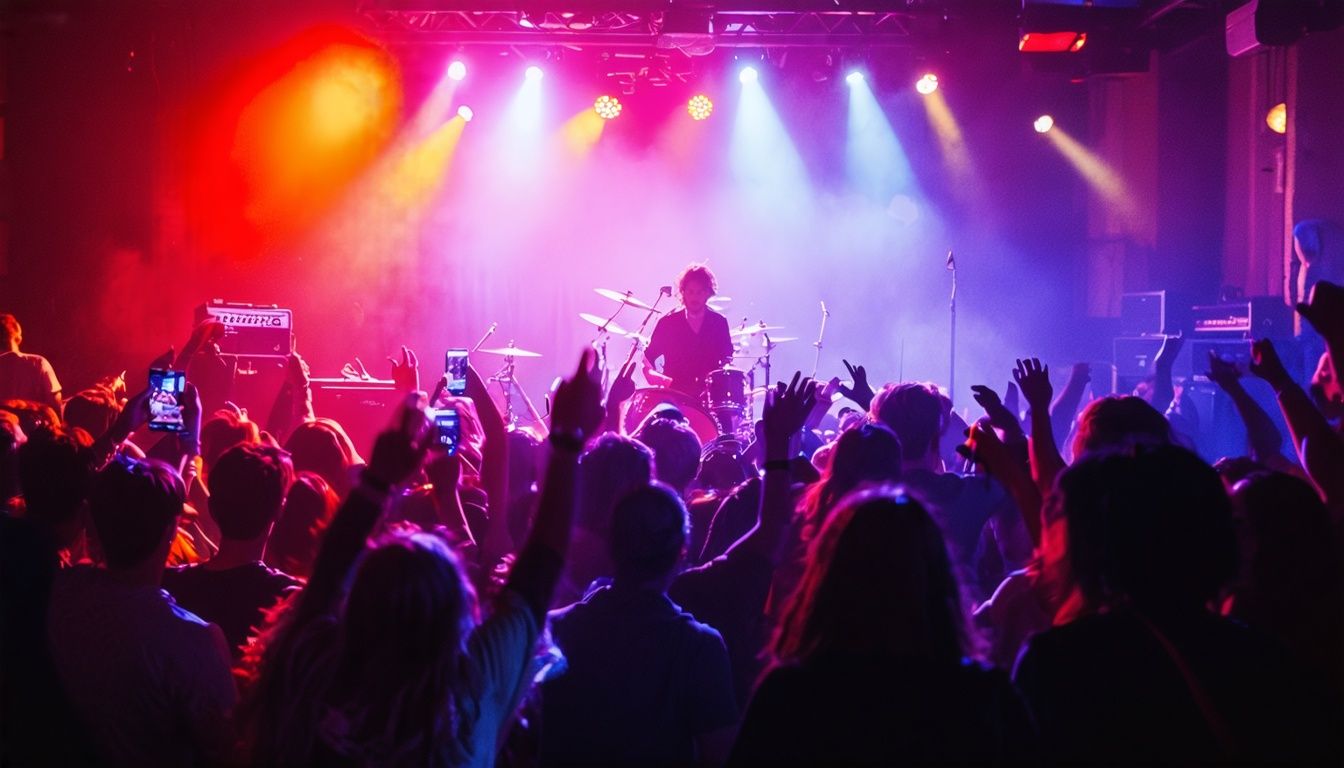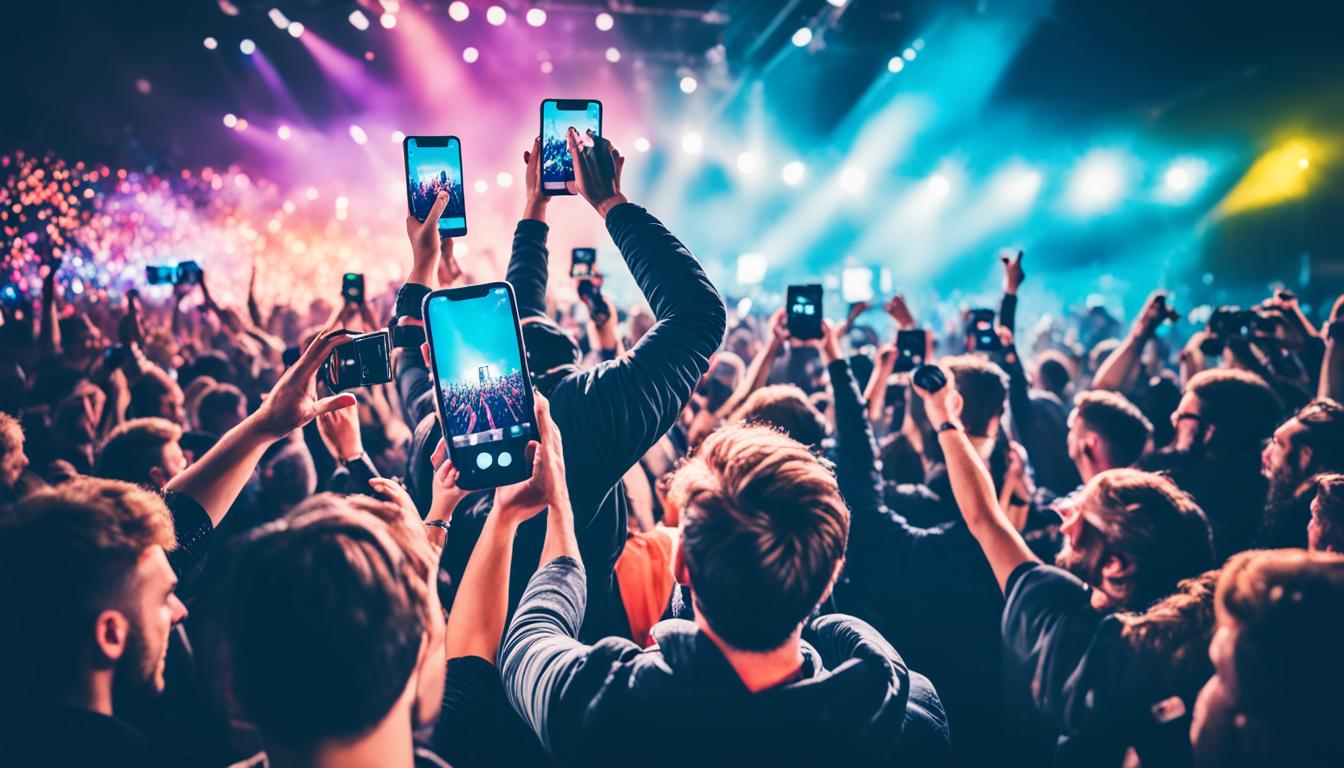Taking concert photos is an exciting fusion of art and music. It challenges photographers in unique ways. It’s not only about taking pictures. It’s also about telling stories through our lenses. We find creative angles to capture the spirit of each performance.
We dive deep into concert scenes to catch intense emotions in every chord and chorus. As the lights flash and the crowd roars, we use our cameras to tell the concert’s story, one photo at a time.
Key Takeaways
- Master composition tips for dynamic concert photos to translate the live music energy into still images.
- Embrace the rapid pace of concert settings to find creative angles for concert photos.
- Enhance storytelling through visuals by using compelling concert photography tips and techniques.
- Adapt quickly to changing lights and movement for capturing the essence of the performance.
- Convey the emotion of the moment with well-composed shots that resonate with the audience.
- Anticipate and react to peak action to preserve timeless memories from live events.
Addressing Concert Photography Challenges
Concert photography is both exciting and tough. We face issues like quick changes in light and performers moving fast. We learn and improve to catch the live music’s spirit. Let’s look at ways to handle these problems, from good framing to setting the camera right for concerts.
Handling Challenging Lighting
Dealing with low light at concerts is tough. We start by making our cameras more sensitive with high ISO. Adding a wide aperture lens helps get more light on our sensors. This is crucial for the dark stages we see. But with high ISO, how do we stop noise? Use RAW. RAW’s detailed data lets us improve shots after the event.
Capturing Fast-Paced Action
Catching action in lively performances is tough but rewarding. A fast shutter speed is key to stop motion without blur. We try to guess the big moments, watching the music and performers closely. This way, we’re ready to capture moments, showing the scene’s true energy.
Understanding Camera Settings in the Concert Scene
Knowing how to set the camera for low light and learning stage photography tips is vital for concert photos. Being able to quickly change settings as the scene changes is important. With high ISO and RAW options, we can create bright, impactful images that people remember long after the concert ends.
Mastering Concert Photography Equipment
Starting our journey in concert photography tips, we first look at the main tool: the equipment. A good camera with high ISO is key for live music photography. But, having the right gear is only half the battle. Knowing when to snap the photo is crucial too.
Long gone are the times of grainy concert pictures. Now, we use advanced cameras and fast lenses to get clear images. These tools let us bring out the best in each shot.
This comparison table shows why we believe in these cameras for their high ISO:
| Camera Model | ISO Performance | Lens Compatibility | Notable Features |
|---|---|---|---|
| Canon EOS-1D X Mark III | Exceptional up to 102400 | Extensive range with EF mount | Dual CFexpress card slots, Deep Learning AF |
| Nikon D850 | Remarkable up to 25600 | Wide variety with F mount | Tilting touchscreen, 45.7MP full-frame sensor |
| Sony Alpha A7R IV | Impressive up to 32000 | E-mount lens family | 61MP sensor, Real-time Eye AF |
Zoom lenses are great because they let us capture every detail, from anywhere. They turn the concert into a work of art.

In the end, being great at concert photography tips isn’t just about the tools. It’s also about using our skills and dynamic composition techniques well. It’s all about getting that perfect shot in live music photography.
Composition Tips for Dynamic Concert Photos
Concert photography is more than random shots; it’s an art. Mastering framing techniques and dynamic composition techniques is key. Understanding these helps us make extraordinary concert memories. We capture live music’s essence and the artists’ passion with each technique.
Utilizing the Rule of Thirds
The rule of thirds is crucial. It guides us in placing key elements in the frame. This balance of structure and creativity improves our photos.
Employing Leading Lines and Creative Angles
Leading lines help make our photos visually appealing. Lines like the stage edge guide the viewer’s gaze. Using different angles adds a new dimension. We can shoot from down low, above, or tilt the camera for effect.
Identifying the Perfect Moment
Good timing means patience and anticipation. Knowing when to capture movement and energy is key. With quick timing and readiness, our photos share the concert experience.
Pay attention to distractions and obstructions in stage photography tips. Avoid microphone stands by watching the vocalist’s position. Knowing about stage lighting is also important for professional shots.
- Align your subjects within the frame for visual interest.
- Look for natural lines that contribute to a narrative flow.
- Use creative vantage points to bring a unique take on the event.
- Be present in the moment and ready for the spontaneous bursts of performance energy.
Exploring motion, light, and rhythm deepens the connection with live music. Our concert photography journey involves ongoing learning and capturing unscripted moments on stage.
The Art of Capturing Emotion and Energy
In the world of live music photography, capturing emotion is key. Close-up shots let us feel the singer’s effort on high notes. Wide shots pull us into the energy of the concert, mixing crowd excitement with stage vibes. Both views together tell the event’s full story.
But taking the photo is just the start. Post-production is crucial in stage photography tips we love. It lets us refine our photos. We can enhance shadows and colors, or choose black and white for impact.
Editing keeps our photos real yet impactful. Each photo is not just an image; it’s a gateway to relive special moments.
Photos tell stories through raw, emotional moments. Whether it’s the connection between artists or the audience’s immersion, those moments create powerful images. In concert photography, our goal is to blend light, action, and emotion into a visual spectacle.
- Close-ups for capturing artist’s expressions
- Wide shots for encompassing concert atmosphere
- Editing to enhance or emphasize the mood
- Authenticity in representing the live energy
The path of live music photography allows us to capture and share the concert’s emotional journey. We have the privilege of preserving moments that resonate with the spirit of the music, long after it’s over.

Conclusion
Exploring concert photography takes us beyond just camera settings. We learn to catch fleeting moments, turning them into lasting memories. It’s like playing a symphony, where each skill adds to the harmony. This lets us create photos filled with the energy and passion of live shows. We dive into the music’s rhythm and the stage’s dynamics, making pictures that tell each song’s story.
We’re always working to better our skills, particularly in creative framing. Photography here is like a dance of light, shadow, movement, and still moments. Every concert brings new challenges—quick lighting changes, unexpected jumps, or the crowd’s emotions. Facing these challenges helps us capture the essence of live music, not just the scenes.
Each obstacle becomes a chance to grow, with our camera know-how leading the way. The unpredictability of concerts is what makes them beautiful. We skillfully connect the bits, making a masterpiece. By practicing, learning, and enjoying the music, we make fleeting moments last. This way, the vibrant energy of performances is never forgotten.
FAQ
How can I manage challenging lighting situations in concert photography?
To handle tough lighting in concert photos, raise your camera’s ISO. This boosts light sensitivity. Also, open your aperture by using a low f-number. And, you might use a slower shutter speed. But, watch out for motion blur.
Shoot in manual mode to adjust ISO, aperture, and shutter speed quickly as lights change. Use lenses with wide apertures, like f/1.8 or f/2.8, to help in low-light areas.
What are some tips for capturing fast-paced action at concerts?
To snap fast action, set your shutter speed to at least 1/250th of a second. Burst mode lets you take lots of shots quickly. This ups your chance of capturing the perfect scene. Know the music and what the performers do on stage. Being in the right place at the right time matters.
Also, lenses with wide apertures help get clear shots in fast-moving scenes.
What camera settings are essential to understand for concert photography?
It’s crucial to know manual mode for concert shoots. It lets you change ISO, aperture, and shutter speed as needed. Also, shoot in RAW for more editing freedom later.
Wait for moments with better lighting before you press the shutter. This gives you more good pictures to use.
What equipment do I need for effective concert photography?
You need a camera good at high ISO for concert photos. Fast lenses with wide apertures also help in low light. Prime lenses offer sharp images, and zoom lenses let you change your framing easily.
Choosing a camera that works well in low light is key to keeping your photos clear.
How can I use the rule of thirds in concert photography for better composition?
For the rule of thirds, imagine your photo split into nine parts by two horizontal and two vertical lines. Place subjects along these lines or where they meet. This makes your photos look balanced and nice.
How can I integrate leading lines and creative angles to create dynamic concert photos?
Use the stage’s shape, mic stands, or instruments as leading lines to focus on your subject. Try different angles like shooting from the side or above. Tilting your camera adds an exciting twist.
These tricks make your concert photos more lively and interesting.
What is the key to identifying the perfect moment in concert photography?
Knowing when to snap the shot is about anticipation and being ready. Understand the artist’s style to guess their next move. Be set to capture it clearly.
Use continuous shooting when expecting a great moment. Know how stage lights work to set your camera right. Patience and quick reactions help catch amazing scenes.
How do I effectively capture emotion and energy in my concert photographs?
Capturing the feel of a concert takes both skill and instinct. Get close for shots that show details like facial expressions. Include wider scenes that show the crowd’s vibe and the place’s energy.
Editing your photos afterwards is key. It can bring out more of the emotion and energy you felt.



